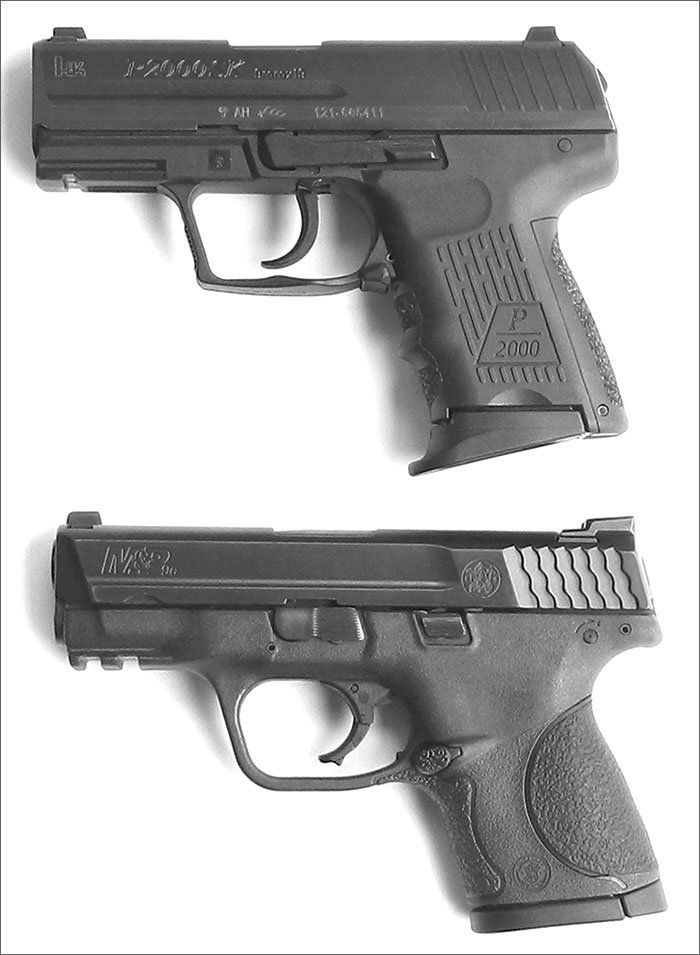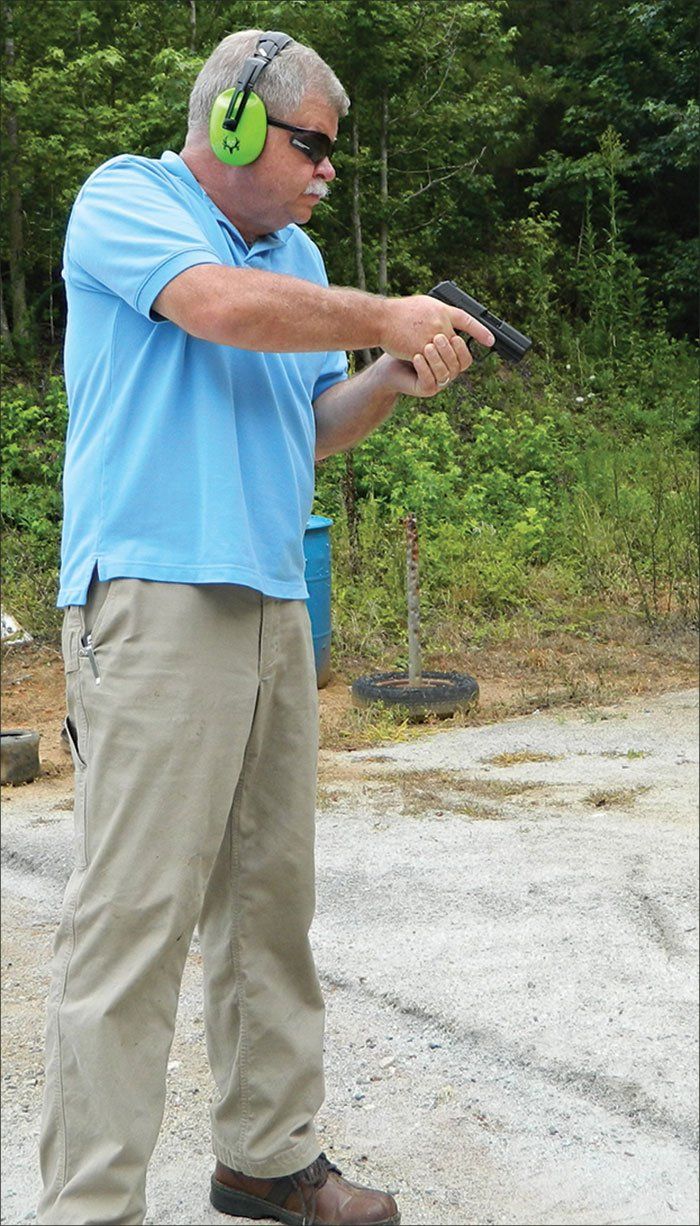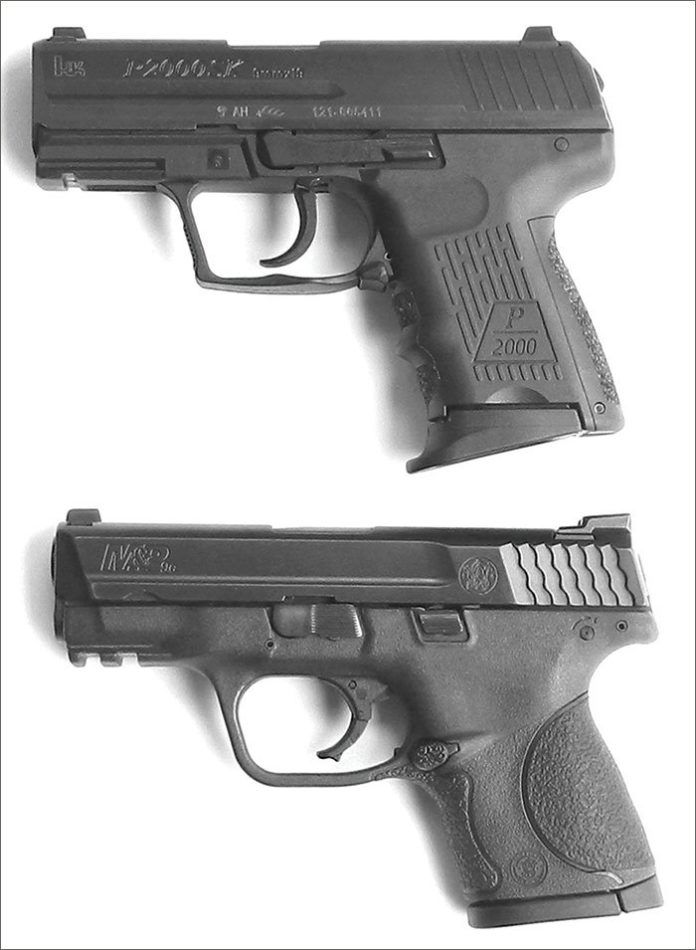For more than one hundred years folks have been trying to make a service pistol fit on the hip under a covering garment. The Colt Sheriffs Model was one of the first such downsized handguns, and today practically every service pistol has a compact version. Many shooters with LE histories prefer this because they feel that a downsized service pistol still has a service-grade action and its operating principles are maintained in the more-compact form; that is, a shorter barrel and slide.

Nowadays, compacts and subcompacts for concealed carry save weight over old-generation handguns because new guns from full-size to subcompact use the same material – polymer – regardless of size. To save weight, older downsized frames had to change materials – aluminum rather than steel. Moreover, the subcompact handgun goes one further and also shortens the grip frame, so at least two dimensions shrink substantially. This is great for comfort and concealment.
The drawbacks for downsized handguns are their reliability and power, which reveals why so many popular compacts and subcompacts are chambered in the 9x19mm round. For many shooters, the 9mm is a realistic minimum for personal-defense use, and its very handy because a shooter can buy just the one caliber and have it run in full-size handguns, subcompact handguns, and carbines by pretty much anyone in the household. The 380 ACP below the 9mm is too little power for many shooters, and the 40 S&W and 45 ACP above it can prove to be a handful for smaller shooters in small guns. With proper load selection and marksmanship, the 9mm represents a reasonable level of power for a practiced shooter.
Toward that end, we selected two popular concealable handguns chambered in 9mm for this test: The Smith & Wesson Military & Police M&P9c #209004 and the H&K P2000SK #709302-A5, the first time weve tested any gun in that line. In the April 2007 issue, we shot and didnt like the M&P9c #209004. Unfortunately, that M&P Compact suffered repeated malfunctions wherein the slide would lock back with one round remaining in the magazine. Failure rate was nearly 70 percent.
In the February 2009 issue, we tried the Smith & Wesson M&P Compact 9mm No. 209304. That gun shot way high and right and not very accurately at 15 yards — groups were around 4 inches.
However, hope springs eternal at the Gun Tests offices, so we cheerily prepped another M&P Compact 9mm and took it to the range.
To evaluate the handguns, they were fired from a solid benchrest-firing position, as we test all handguns. However, in this case the pistols were fired for groups at 15 yards rather than the 25 yards assigned for service pistols. The short sight radius and double-action trigger simply doesnt lend itself well to pinpoint accuracy.
A portion of the test that is more important to personal defense shooters is the combat firing test. This test began with man-sized silhouette targets placed at 5, 7, and 10 yards. Each pistol was drawn from concealed carry.

The Smith & Wesson was carried in a Discreet Defense Solutions inside-the-waistband holster (DiscreetDefenseSolutions.com). This holster has a good fit and comfort, and something we really needed in 98-degree heat – a sweat guard. From Mernickle Holsters
(MernickleHolsters.com) came an all-leather IWB with a strong spring-steel belt clip and a generous sweat guard. This holster was actually ordered for a Baby Eagle pistol, but it fit the H&K 2000 just fine. The pistols were belted on under a lighter covering garment, most often a sport shirt, during testing. During the combat-shooting stage, we used primarily HPRs 115-grain full metal jackets, a few 115-grain jacketed hollowpoint loads from the same maker, and Federal American Eagle 115-grain FMJs. We also were able to fire a magazine with the Winchester 127-grain SXT +P+ loads. Like many of you, we have mixed boxes left over from previous projects and this was the time to use it. The results were interesting.
Smith & Wesson M&P9cNo. 209004 9mm Luger, $480
The cost reflects actual pricing from Cheaper Than Dirt! at the time of testing, without shipping and transfer fees. More recently, this gun is listed at CTD for $442. Because the H&K P2000SK was listed at Cheaper Than Dirt! at the same time for $866, that made the price difference at the time of the test $386.
The Smith & Wesson Military & Police self loader is aimed at the market dominated by Glock. Excellent human engineering and good features have resulted in Smith & Wesson gaining a respectable market share in this niche. The smaller version retains the good features of the original full-size pistol. The H&K 2000 is designed to compete in the law-enforcement and personal defense markets. An agency choosing the H&K 2000 handgun has assured the troops that the brass has not purchased a handgun on the low bid.
The Smith & Wesson had several design features that all of the raters liked. The slide design was stylish and the cocking grooves gave plenty of leverage. The H&K cocking grooves worked fine, but we liked the Smith & Wesson better.
The slide was tapered toward the front to allow easy insertion into a tightly molded holster. The slide lock was ambidextrous; the magazine release was not. The frame was nicely stippled across the back strap; the front strap texture wasnt as aggressive. The Smith & Wesson magazines held 11 rounds, one more than the H&K. One seemed stiffer than the other, but there were no function issues.
The raters liked the sights. The rear sight isnt a Novak, but it was high profile and low snag. The front sight was nicely dovetailed in place.
The Smith & Wesson featured a loaded-chamber indicator that works visually only. There was a light rail, albeit a short one.
Trigger compression broke at 6 pounds even. When testing the trigger, we hooked the RCBS registering trigger-pull gauge up, and the trigger did not budge. We had to be certain the hinged component at the bottom of the trigger was actuated. We liked that.
During combat firing, the Smith & Wesson gave good to excellent handling results for a compact handgun. The grip was a little shorter than the H&K, but just the same, we were in control of the pistol. When it came time to measure the back strap, the difference wasnt as great as we thought – the H&Ks curve doesnt allow as much gripping space. During the firing stage, the difference in accuracy potential was more evident during the 10-yard combat-firing test, with the Smith & Wesson delivering tighter groups. During speed reloads, our shooters handled the magazine release of the M&P quickly.
During benchrest firing, the M&P9c gave better accuracy than the H&K 2000. This was not expected, as H&K handguns are often very accurate. The longer trigger of the H&K 2000 seemed to be the problem. The most accurate choice was the Speer 124-grain Gold Dot, which notched an average group size of 2.0 inches at 15 yards.
After the shooting comes the cleaning. The raters liked the breakdown of the M&P better. Unload the pistol, remove the magazine, lock the slide back, twist the lever, and then release the slide to allow it to run forward off the slide. The recoil spring and guide and barrel are easily removed.
Our Team Said: During the test, we saw no failures to feed, chamber, fire, or eject. The price differential of the two handguns has to be taken into consideration. In this case the less-expensive handgun was the better performer.
Heckler & Koch P2000SK #709302-A59mm Luger, $866
The H&K P2000SK is a subcompact version of the H&K P2000 service pistol. Its fit and finish were good, and the appearance of the pistol was one of quality manufacturing. The pistol had a stout and purposeful look. Unlike the striker-fired M&P, the H&K features an external hammer. This was no liability in concealed carry, we found. The slide-cocking serrations worked well enough, and the slide was beveled for easy insertion in the holster. The trigger guard was squared with a slightly greater interior area for gloved-hand use. The pistol featured a loaded-chamber indicator in the form of an extractor that protruded when the chamber was loaded. There was a dab of red enamel on the extractor to signify its condition.
We liked the texture of the frame stippling, but our shooters did not care for the finger-groove extension on the front strap. There were slight indentations in the grip frame giving slightly better access to the trigger by shortening trigger reach.
The double-action trigger broke at 7.5 pounds, but its action was the primary impediment to accuracy, we believe. This was a double-action-only trigger with a difference. The slide partially sets the hammer when the slide is racked. The trigger is then a relatively short and smooth 7.5 pounds. However, if there is a failure to fire due to a defective primer, the pistols trigger may be pressed again and again to ignite the round. It was much heavier at 10 to 12 pounds in this mode, but some feel that this second-strike capability is important.
During the firing tests, the pistol gave good results at all combat ranges, but it was bettered by the Smith & Wesson 9mm during combat testing. Most of us are more familiar with the Browning-type magazine release. However, one of the raters owns both an H&K P30 and an H&K P7M8. He was able to demonstrate a brilliantly rapid magazine reload with the H&K magazine release. The release is pressed straight down and is ambidextrous. Another advantage was the long slide lock, and this certainly helped in speed loads. In our view, the H&K 2000 is the noticeably faster gun to reload in the hands of a well-trained shooter.
The H&K produced slightly slower velocities than the Smith & Wesson, with the high-velocity loads as much as 21 fps slower in the H&K, but with some only 8 fps slower, an inconsequential difference. Another rater is a long-time double-action-revolver shooter and provided the best groups with the H&K, but not the average. He placed three shots of the Federal 147-grain JHP into an inch at 15 yards, but could not maintain this average. Even he shot better with the M&P 9mm.
Another rater was looking over the H&K, and she did not like that the spring the magazine catch attaches to was visible under the catch. Debris could get in the slot over time, but this didnt affect function for us.
We did not like the field strip as well as the Smith & Wessons. The slide was locked to the rear, and the slide lock was pressed out to the left. This means the slide lock is not captive. This isnt as modern as the Smith & Wesson, we felt.
Our Team Said: In the end, the H&K seems to be a fine handgun. It is reliable and accurate. The tactical reload is brilliantly fast in trained hands. It also offers a second-strike capability. Still, while the H&K is a good combat gun, it isnt the better buy in this test. The Smith & Wesson outperformed it, in our opinion.
Written and photographed by Bob Campbell, usingevaluations from Gun Tests team testers. GT
































